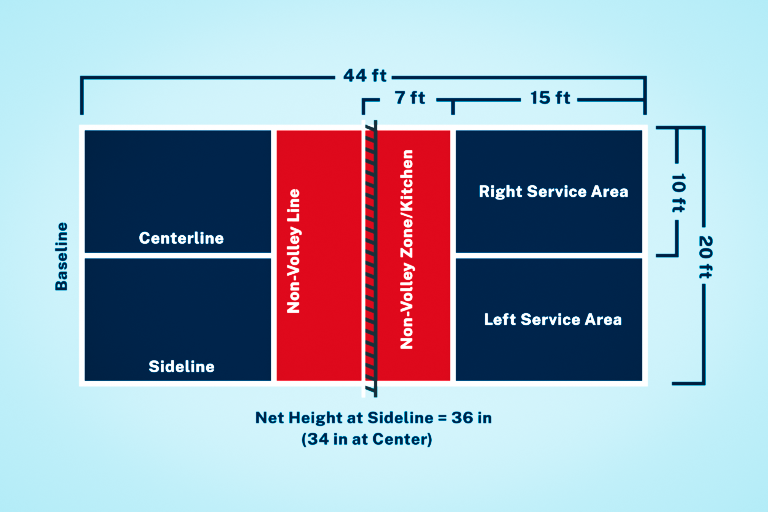What Is Pickleball
Pickleball is a super fun and social game that’s easy to pick up and play, even if a person is unaware of these sports or you’re new to these sports. This article will help you to provide the some deep insight about the sports pickleball from scratch to bottom with most easier ways of understanding.
It is a mix of tennis, badminton, and ping-pong games , which seems to be more laid back and accessible format to play.Here’s the scoop:
Pickleball is played on a small court (20 x 44 feet), about one-fourth the size of a tennis court. In the middle is a net that looks like a lower version of a tennis net. You can play it either one-on-one (singles) or two-on-two (doubles)—doubles is the more popular version.
How To Play Pickleball And its Basic Rules
1.Serving
- Underhand Serve: while serving the ball must be served underhand (no overhand serves is allowed) and hit below the waist.
- Serve Diagonally: The server had to hit the ball diagonally across the net into the opponent’s service court. The serve must clear the net and land beyond the “kitchen” (non-volley zone).
- One Serve Attempt: Unlike tennis, a server is won’t allow for two tries . If you miss the serve (it hits the net or goes out), it’s a fault, and the serve goes to the other team.
- Switching Servers: In doubles, both players on a team get a chance to serve before it goes to the other side. Only the first server on a team serves once before the other side serves.
2. Double Bounce Rule
- After the serve, the ball must bounce once on each side of the net before players can hit it out of the air (volley).
- So, when you receive a serve, you must let it bounce, and then when the server returns the ball, they must also let it bounce. After that, volleys are allowed.
3. The Kitchen (Non-Volley Zone)
- Stay Out of the Kitchen: A player is not allowed to volley the ball (hit it in the air) if they are inside the 7-foot area in front of the net, known as the “kitchen.”
- Feet Rules: The players feet can’t be in the kitchen when volleying, and you can’t step into the kitchen after hitting a volley. It’s fine to step in if you’re playing a ball off a bounce.
- This rule prevents players from hanging out at the net and smashing the ball.
4. Scoring
- Points on Serve: The players can only score points when their team is serving.
- Game to 11, Win by 2: Games are usually played to 11 points, and you have to win by 2. For example, you might need to win 12-10 or 13-11.
- Side-Out: If the serving team loses a rally (hits the ball out, into the net, or violates a rule), the serve goes to the opposing team without them gaining a point.
5. Faults
Common faults include:
- The ball landing out of bounds.
- The ball not clearing the net.
- Volleying the ball before the double bounce rule is satisfied.
- Stepping into the kitchen while volleying the ball.
The Equipment
- Paddles: The players uses a paddle that is s a bit bigger than a ping-pong paddle but smaller than a tennis racket. It is lightweight and easy to handle.
- Ball: The ball is made of plastic, which is light, and has holes in it, sort of like a wiffle ball. It doesn’t bounce too high or move too fast, so it’s forgiving for beginners.
- Court: The court is small, with a special area near the net called “the ki

How It Starts
The game begins with one player serving the ball by underhand from behind the baseline. The serve must land diagonally on the other side of the net and outside the kitchen zone.
Once the serve is made, both teams allows the ball bounce once before hitting it back (this is called the “double bounce rule”). After that, the ball can be hit either on the bounce or volleyed (without a bounce).
The Kitchen
Here is where it gets fun: The “kitchen” is a 7-foot area on both sides of the net where the players are not allowed to hit volleys. This rule prevents people from camping out at the net and smashing the ball, keeping the game balanced.

Why It’s So Popular
- Easy to Learn: The small court and slower ball make these sport much easier for people of all ages and skill levels to get into the game quickly.
- Social: You can have fun, friendly matches without feeling too competitive, making it great for casual play.
- Low-Impact: It is gentler on the joints compared to tennis, so it’s appealing to older adults as well as younger players.
The End of the Game
The game comes to end when one team reaches 11 points and wins by at least 2 points. The pace is fast, the rules are simple, and the emphasis is on having fun. Whether you’re smashing the ball or just working on dinks, pickleball is a game that gets everyone moving and smiling.
